The Story of the Inca Empire
Reading time: 13 min
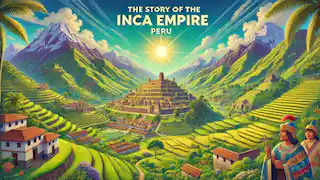
About this story: The Story of the Inca Empire is a Historical Fiction from Peru set in the Medieval This Descriptive tale explores themes of Perseverance and is suitable for All Ages. It offers Historical insights. A captivating tale of the rise and fall of the Inca Empire, revealing their ingenuity and lasting legacy.
Chapter 1: The Dawn of an Empire
Long ago, nestled high in the Andes Mountains, a civilization emerged that would become one of the most powerful and influential in pre-Columbian America. The Inca Empire, known as Tawantinsuyu, meaning "The Four Regions," began its rise in the early 13th century. Founded by Manco Cápac, the first Sapa Inca, the empire's capital was established in Cusco, a city that would grow to be the heart of Inca power and culture.
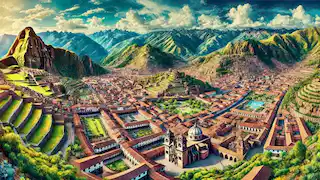
Cusco, located at an elevation of over 11,000 feet, was more than just a political hub; it was a symbol of the Inca's divine mission. The Incas believed that their rulers were direct descendants of Inti, the sun god, who had chosen them to lead his people. This divine connection was central to Inca society and governance, infusing their every action with spiritual significance. The sacred geography of Cusco, with its rivers and mountains believed to represent celestial alignments, reinforced the notion that the city was at the center of the universe.
As the Inca expanded their territory, they absorbed various Andean cultures, creating a vast empire that spanned from modern-day Colombia to Chile. Their expansion was not merely a conquest but an assimilation, where the Incas incorporated the customs, languages, and technologies of the people they conquered. This approach fostered a sense of unity and stability within the empire. The Inca administration allowed a degree of local autonomy, integrating local leaders into their governance structure, which helped in maintaining order and loyalty among the conquered peoples.
Chapter 2: The Inca Society
The Inca society was meticulously organized. At the top of the hierarchy was the Sapa Inca, the emperor, who wielded absolute power. Below him were the nobility, including priests and high-ranking military officials, who helped administer the vast empire. The common people, known as hatun runa, formed the backbone of Inca society, engaging in agriculture, craftsmanship, and labor.
Agriculture was the cornerstone of the Inca economy. The Incas mastered the art of terrace farming, transforming the steep mountainsides into fertile fields. They cultivated crops such as maize, potatoes, quinoa, and coca, which were crucial for their sustenance and trade. Their innovative irrigation systems ensured a steady water supply, even in the arid highlands. These terraces and canals were engineering marvels, demonstrating the Incas' deep understanding of their environment and their ability to manipulate it for agricultural productivity.
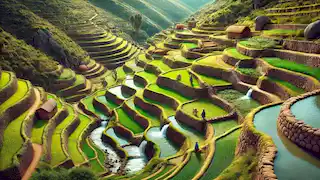
The Inca's architectural prowess is evident in the remnants of their cities and temples. Machu Picchu, perhaps the most famous Inca site, stands as a testament to their engineering skills. Built with precisely cut stone blocks that fit together without mortar, the structures have withstood centuries of earthquakes and weathering. The city served as a royal estate and religious site, reflecting the Incas' deep connection to their environment and gods. The architecture of Machu Picchu, with its astronomical alignments, suggests that it also served as an observatory and a site for studying celestial phenomena.
Religion was deeply intertwined with every aspect of Inca life. They worshipped a pantheon of gods, with Inti, the sun god, being the most revered. The Inca priests conducted elaborate ceremonies to honor their deities, believing that these rituals ensured the prosperity and stability of their empire. The most significant religious event was the Inti Raymi, the Festival of the Sun, held annually in Cusco to celebrate the winter solstice. During this festival, the Sapa Inca and his subjects offered sacrifices to Inti, seeking his blessings for a bountiful harvest and protection for the empire.
Chapter 3: The Road to Expansion
The Inca Empire's expansion was both strategic and relentless. Pachacuti, the ninth Sapa Inca, is often credited with transforming the Inca state into a vast empire. His military campaigns extended the empire's borders, bringing diverse cultures under Inca rule. However, Pachacuti's approach to conquest was unique; he preferred diplomacy and alliances over outright warfare.
Under Pachacuti's leadership, the Incas implemented a system of roadways, known as the Qhapaq Ñan, which spanned over 25,000 miles. These roads facilitated communication, trade, and military movement across the rugged Andean terrain. Chasquis, or messenger runners, were stationed at intervals along these roads, enabling rapid transmission of information across the empire. These roads, some of which are still in use today, connected distant corners of the empire, allowing for efficient administration and movement of goods and people.
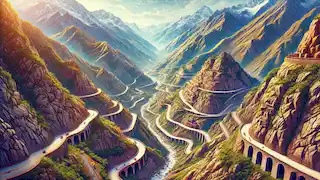
Pachacuti also introduced administrative reforms that enhanced the efficiency of Inca governance. The empire was divided into four suyus, or regions, each overseen by a governor who reported directly to the Sapa Inca. This decentralized administration allowed for better management of the diverse and widespread territories. Additionally, Pachacuti established the system of Mit'a, which required every able-bodied citizen to contribute labor to state projects. This system ensured the construction of infrastructure and reinforced the communal values of Inca society.
Chapter 4: The Golden Age
The reign of Huayna Capac marked the zenith of the Inca Empire. Under his rule, the empire reached its greatest extent, encompassing millions of people from different ethnic and cultural backgrounds. Huayna Capac maintained the stability of the empire through a combination of military strength, diplomatic marriages, and religious unity.
The Incas were master builders, and during this period, they constructed some of their most iconic structures. The Coricancha, or Temple of the Sun, in Cusco, was adorned with gold and dedicated to Inti. It served as the spiritual center of the empire, where priests conducted important rituals and ceremonies. The wealth of the empire was evident in the gold and silver that decorated their temples and palaces. The walls of Coricancha were lined with sheets of gold, reflecting the importance of Inti in the Inca religion and the prosperity of the empire.
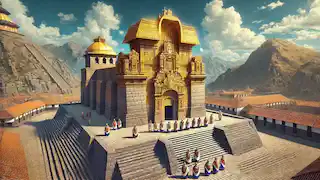
Trade flourished under Huayna Capac's rule. The Inca economy was based on a barter system, with goods exchanged for other goods or labor. The Mit'a system, a labor tax, required citizens to contribute work to state projects, such as building roads, temples, and agricultural terraces. This system not only ensured the completion of public works but also reinforced the communal values of Inca society. The empire's extensive network of storehouses, or qollqas, ensured that surplus food and goods were available during times of scarcity, providing a buffer against famine and reinforcing the empire's stability.
Despite the prosperity, Huayna Capac's reign was not without challenges. A series of natural disasters, including earthquakes and epidemics, tested the resilience of the empire. These events were seen as signs of displeasure from the gods, prompting the Incas to intensify their religious practices and offerings. The empire also faced external threats from neighboring tribes and internal dissent, which required constant vigilance and military readiness.
Chapter 5: The Art and Culture of the Incas
Inca art and culture were deeply influenced by their religious beliefs and their connection to nature. Their art included textiles, pottery, metalwork, and stone carving, all of which were created with great skill and attention to detail. Textiles, in particular, were highly valued in Inca society. The intricate patterns and vibrant colors of Inca textiles were not only beautiful but also conveyed social status and cultural identity.
Inca pottery often depicted scenes from daily life, religious rituals, and mythological stories. The Incas used a unique method of ceramic production, creating vessels that were both functional and decorative. Their metalwork, especially in gold and silver, was renowned for its craftsmanship. The Incas created elaborate jewelry, ceremonial items, and tools, often adorned with intricate designs that reflected their religious and cultural beliefs.
Music and dance were also integral parts of Inca culture. They used a variety of musical instruments, including flutes, drums, and panpipes, to create music for religious ceremonies, festivals, and daily activities. Dance was often performed during religious rituals and celebrations, with each dance telling a story or honoring a particular deity.
Chapter 6: The Inca Military
The Inca military was a formidable force, known for its organization, discipline, and strategic prowess. Every able-bodied male was required to serve in the military, and the Incas trained their soldiers rigorously. The army was divided into units based on the decimal system, with each unit commanded by an officer who reported up the chain of command to the Sapa Inca.
The Inca soldiers were equipped with a variety of weapons, including spears, slings, bows and arrows, and clubs. They wore armor made from padded cotton and carried shields for protection. The Incas also used psychological warfare, including intimidation tactics and strategic alliances, to weaken their enemies before engaging in battle.
The Inca's military strategies were based on their knowledge of the terrain and their ability to mobilize large numbers of troops quickly. The extensive road network allowed for rapid deployment of soldiers to different parts of the empire. The Incas also built fortresses and defensive structures to protect their territories from invaders.
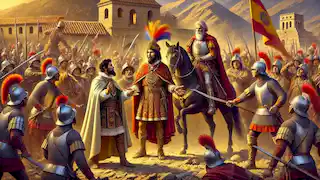
Chapter 7: The Road to Expansion
The Inca Empire's expansion was both strategic and relentless. Pachacuti, the ninth Sapa Inca, is often credited with transforming the Inca state into a vast empire. His military campaigns extended the empire's borders, bringing diverse cultures under Inca rule. However, Pachacuti's approach to conquest was unique; he preferred diplomacy and alliances over outright warfare.
Under Pachacuti's leadership, the Incas implemented a system of roadways, known as the Qhapaq Ñan, which spanned over 25,000 miles. These roads
facilitated communication, trade, and military movement across the rugged Andean terrain. Chasquis, or messenger runners, were stationed at intervals along these roads, enabling rapid transmission of information across the empire.
Pachacuti also introduced administrative reforms that enhanced the efficiency of Inca governance. The empire was divided into four suyus, or regions, each overseen by a governor who reported directly to the Sapa Inca. This decentralized administration allowed for better management of the diverse and widespread territories.
Chapter 8: The Inca Society
The Inca society was meticulously organized. At the top of the hierarchy was the Sapa Inca, the emperor, who wielded absolute power. Below him were the nobility, including priests and high-ranking military officials, who helped administer the vast empire. The common people, known as hatun runa, formed the backbone of Inca society, engaging in agriculture, craftsmanship, and labor.
Agriculture was the cornerstone of the Inca economy. The Incas mastered the art of terrace farming, transforming the steep mountainsides into fertile fields. They cultivated crops such as maize, potatoes, quinoa, and coca, which were crucial for their sustenance and trade. Their innovative irrigation systems ensured a steady water supply, even in the arid highlands.
The Inca's architectural prowess is evident in the remnants of their cities and temples. Machu Picchu, perhaps the most famous Inca site, stands as a testament to their engineering skills. Built with precisely cut stone blocks that fit together without mortar, the structures have withstood centuries of earthquakes and weathering. The city served as a royal estate and religious site, reflecting the Incas' deep connection to their environment and gods.
Religion was deeply intertwined with every aspect of Inca life. They worshipped a pantheon of gods, with Inti, the sun god, being the most revered. The Inca priests conducted elaborate ceremonies to honor their deities, believing that these rituals ensured the prosperity and stability of their empire. The most significant religious event was the Inti Raymi, the Festival of the Sun, held annually in Cusco to celebrate the winter solstice.
Chapter 9: The Golden Age
The reign of Huayna Capac marked the zenith of the Inca Empire. Under his rule, the empire reached its greatest extent, encompassing millions of people from different ethnic and cultural backgrounds. Huayna Capac maintained the stability of the empire through a combination of military strength, diplomatic marriages, and religious unity.
The Incas were master builders, and during this period, they constructed some of their most iconic structures. The Coricancha, or Temple of the Sun, in Cusco, was adorned with gold and dedicated to Inti. It served as the spiritual center of the empire, where priests conducted important rituals and ceremonies. The wealth of the empire was evident in the gold and silver that decorated their temples and palaces.
Trade flourished under Huayna Capac's rule. The Inca economy was based on a barter system, with goods exchanged for other goods or labor. The Mit'a system, a labor tax, required citizens to contribute work to state projects, such as building roads, temples, and agricultural terraces. This system not only ensured the completion of public works but also reinforced the communal values of Inca society.
Despite the prosperity, Huayna Capac's reign was not without challenges. A series of natural disasters, including earthquakes and epidemics, tested the resilience of the empire. These events were seen as signs of displeasure from the gods, prompting the Incas to intensify their religious practices and offerings.
Chapter 10: The Fall of an Empire
The decline of the Inca Empire began with the arrival of the Spanish conquistadors in the early 16th century. Francisco Pizarro and his men, driven by the promise of gold and glory, set their sights on the riches of the Inca Empire. The Spanish conquest was facilitated by internal strife, as a civil war had erupted between Huayna Capac's sons, Atahualpa and Huascar, over succession.
The Spaniards exploited this division, forging alliances with factions within the empire. The Inca's lack of advanced weaponry and their belief in the divine protection of their empire proved to be their undoing. Atahualpa, who had emerged victorious in the civil war, was captured by Pizarro during the Battle of Cajamarca. Despite paying a ransom of gold and silver, Atahualpa was executed, and the Inca resistance crumbled.
The fall of Cusco in 1533 marked the end of the Inca Empire as an independent entity. The Spanish imposed their rule, dismantling the Inca political and social structures. However, the legacy of the Incas endured, influencing the culture and traditions of the Andean people for centuries to come.
Conclusion
The story of the Inca Empire is one of ingenuity, resilience, and profound spiritual connection. From their humble beginnings in Cusco to their vast empire that spanned the Andes, the Incas demonstrated unparalleled skill in governance, architecture, and agriculture. Their ability to adapt and assimilate various cultures into their own created a unified and prosperous society.
Despite their eventual fall to the Spanish conquistadors, the Inca legacy lives on in the ruins of their cities, the terraces that still support agriculture, and the rich cultural heritage of the Andean people. The Inca Empire remains a testament to the heights that human civilization can achieve through unity, innovation, and a deep respect for the natural world.


















